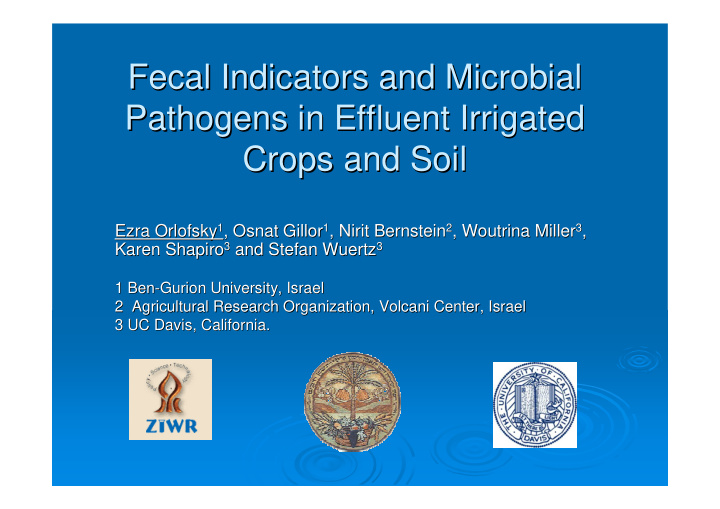



Fecal Indicators and Microbial Fecal Indicators and Microbial Pathogens in Effluent Irrigated Pathogens in Effluent Irrigated Crops and Soil Crops and Soil 1 , Osnat Gillor 1 , Nirit Bernstein 2 , Woutrina Miller 3 , Ezra Orlofsky 1 , Osnat Gillor 1 , Nirit Bernstein 2 , Woutrina Miller 3 , Ezra Orlofsky 3 and Stefan Wuertz 3 Karen Shapiro 3 and Stefan Wuertz 3 Karen Shapiro 1 Ben 1 Ben- -Gurion University, Israel Gurion University, Israel 2 Agricultural Research Organization, Volcani Center, Israel 2 Agricultural Research Organization, Volcani Center, Israel 3 UC Davis, California. 3 UC Davis, California.
Wastewater- - Its not all waste Its not all waste Wastewater � Many countries, especially poor and developing Many countries, especially poor and developing � ones, reuse wastewater in some way. ones, reuse wastewater in some way. � Wastewater is cheap, high in nutrients and Wastewater is cheap, high in nutrients and � available even in countries with water scarcity available even in countries with water scarcity problems. problems. � There is a need to assess the risks associated There is a need to assess the risks associated � with wastewater usage, especially vis- -à à- -vis vis with wastewater usage, especially vis agricultural application. agricultural application. � Adhesion to produce Adhesion to produce � � Survival/accumulation in soil Survival/accumulation in soil �
Israeli Policy Israeli Policy � Zero tolerance Zero tolerance � � Barrier method Barrier method � � Irrigating trees/horticulture only Irrigating trees/horticulture only � � Reallocation of potable water to the sector Reallocation of potable water to the sector � that needs it most that needs it most
Safety Guidelines Safety Guidelines � “ “Pathogens are rarely measured directly in Pathogens are rarely measured directly in � wastewater, because their concentrations vary wastewater, because their concentrations vary and analytical procedures are often difficult or and analytical procedures are often difficult or expensive to perform.” ” expensive to perform. – Guidelines for the safe use of wastewater, excreta and greywater Guidelines for the safe use of wastewater, excreta and greywater, vol 2 (WHO, , vol 2 (WHO, – 2006). 2006). � It is standard practice to assess microbial It is standard practice to assess microbial � contamination with indicator organisms contamination with indicator organisms � Total Coliform/E. coli Total Coliform/E. coli � � Enterococcus Enterococcus � � Viral indicators Viral indicators �
Objectives Objectives � Comparing the effectiveness of the Comparing the effectiveness of the “ “Indicator Indicator” ” � method to predict a health risk in soil and crops method to predict a health risk in soil and crops irrigated with treated effluents. irrigated with treated effluents. � Direct, quantitative testing of pathogens using Direct, quantitative testing of pathogens using � both culture dependent and culture independent both culture dependent and culture independent methods. methods. � Water: Ultrafiltration with cut Water: Ultrafiltration with cut- -off >35 KD off >35 KD � � Quantitative testing of indicators according to Quantitative testing of indicators according to � standard means standard means � Water/Produce : EPA Water/Produce : EPA � � Soil: Microbiology literature Soil: Microbiology literature �
Experimental Design Experimental Design Effluent/ Potable water Water Sample 5 Plots (N=5) Soil Sample Tomato Sample
Method validation – – Recoveries Recoveries Method validation from spiking studies from spiking studies � Protozoa are ~50% recoverable from all Protozoa are ~50% recoverable from all � matrices matrices � Culture dependent methods for bacteria Culture dependent methods for bacteria � show high replicability for water (70- -80%), 80%), show high replicability for water (70 but not for soil but not for soil � qPCR tends to show >100% recovery, but qPCR tends to show >100% recovery, but � within reason. within reason. � Standard methods for indicators are Standard methods for indicators are � replicable replicable
Results- - Effluent Water Effluent Water Results � Coliforms were always Coliforms were always � Effluent Water Characteristics detected in high detected in high abundance abundance 500 � Enterococcus and E. Enterococcus and E. � coli coli- - sometimes sometimes 400 CFU/100 mL Coliforms � Salmonella was Salmonella was � 300 Enteroccocus detected (putatively) in detected (putatively) in 200 E. Coli the time 2, as well as the time 2, as well as Salmonella E. coli E. coli 100 � Protozoa was detected Protozoa was detected � 0 at time 1 at levels that at time 1 at levels that time 0 time 1 time 2 approach the limit of approach the limit of detection detection
Soil Results Soil Results � In Soil, coliforms In Soil, coliforms � appear to be the appear to be the major indicator group major indicator group 100000 Coliforms present- - perhaps perhaps present Enterococcus 10000 E. Coli environmental environmental Salmonella 1000 � Salmonella (putative) Salmonella (putative) � 100 was identified in both was identified in both 10 treatment plots. treatment plots. 1 Tap 0 Eff 0 Tap 1 Eff 1 Tap 2 Eff 2
Interim Conclusions Interim Conclusions � Currently, the indicators exceed the Currently, the indicators exceed the � pathogens (represented by Salmonella) pathogens (represented by Salmonella) � Waiting for qPCR results Waiting for qPCR results �
Conclusion Conclusion �יבר��ימעל�חיכוהו��יוגה��יב�טפשו � ���היתותינחו��יתאל��תוברח�ותתכו �תורמזמל �דוע�ודמלי־אלו�ברח�יוג־לא�יוג�אשי־אל �׃המחלמ And they will hammer their swords into plowshares and their spears into pruning hooks. Nation will not lift up sword against nation, And never again will they learn war
Recommend
More recommend